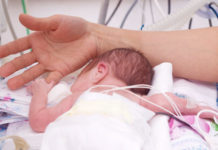We all know that babies don’t really come from the cabbage patch or a stork’s beak, but how much do you really know about getting pregnant? Yes, you have to have sex and it’s something to do with egg and sperm coming together. But there’s a little more to it than that.
Although it’s fairly easy for most women to get pregnant, the unseen work that your body does to make the pregnancy happen is incredibly complex. If you’re planning a pregnancy, you’ll be fascinated to know about all the unseen changes which will occur during ovulation and conception, before you even realise you’re pregnant.
In the beginning
Pregnancy, somewhat confusingly, begins before you have even conceived your baby. From the time your menstrual cycle begins with your monthly period, your body is starting to prepare for ovulation, fertilisation and implantation of the fertilised egg. And you’re already in Week 1 of pregnancy, at least according to the way doctors count pregnancy week by week!
The first 10-14 days of your menstrual cycle are called the follicular phase, named so because it is during this phase that a follicle in your ovaries grows. Waiting patiently in that follicle is a maturing egg which will be released and travel to your womb when you ovulate. Should it be fertilised by your partner’s sperm, it will reside for the next nine or so months in your womb, which, in the follicular phase of your menstrual cycle, is already preparing baby’s temporary pregnancy home.
Maturation of your egg
In the first week of the follicular phase, several out of the thousands of follicles in your ovary begin to mature, as a result of the aptly named follicle stimulating hormone. This hormone is produced in large amounts during the follicular phase and stimulates your ovarian follicles to mature the eggs that they hold. By the end of the first week of the follicular phase, a single follicle has become dominant (unless your body is preparing you for twin babies, in which case there will be two dominant follicles). The dominant follicle uses up most of the blood and is larger than all the other follicles.
It begins producing oestrogen which triggers your body to make luteinising hormone, in the second week of the follicular phase (8-14 days after the start of your last period). This is the hormone which causes the egg held in the dominant follicle to mature ready for release when you ovulate. You could think of the egg as a very tiny piece of fruit on a very tiny tree, ripening and waiting for a gust of wind to knock it down. In the case of your ovaries, the gust of wind that causes your egg to drop, is a surge in the level of luteinising hormone, which occurs when the egg is fully matured. Unless you’re monitoring your temperature every morning before you get out of bed, you won’t notice it, but your temperature will rise ever so slightly (by 0.2-0.3oC) when you ovulate.
Preparation of your womb
 While all these changes are occurring in your ovaries, the hormones being produced are also hard at work a little further down your reproductive tract, in your womb. A growing baby needs comfort and nourishment, and your hormones seem to know that. While they stimulate your egg to mature, they’re also preparing a new home for your baby to spend the nine months of pregnancy, and food to get it through the first few days after fertilisation.
While all these changes are occurring in your ovaries, the hormones being produced are also hard at work a little further down your reproductive tract, in your womb. A growing baby needs comfort and nourishment, and your hormones seem to know that. While they stimulate your egg to mature, they’re also preparing a new home for your baby to spend the nine months of pregnancy, and food to get it through the first few days after fertilisation.
But it’s not a clean sheets and freshly baked bread kind of home. Should conception occur, your fertilised egg will begin its growth in a thick and nutritious layer of blood and sugary mucus. Known as the endometrial lining, this layer falls away and is shed during menstrual bleeding- if you don’t get pregnant. If you do get pregnant, it provides your baby with all the nutrients it needs to survive and grow healthy, from the time it enters your womb, until the placenta which will nourish it throughout the pregnancy forms a few days later.
Ovulation
Ovulation, the release of an egg from your ovaries, typically occurs at the end of the second week, on day 14 of your menstrual cycle. Depending on the length and regularity of your periods, your egg may be released anytime from day 10-16. It’s ripe for fertilisation at this time but still too tiny too be seen- it measures just 1/10th of 1mm. Once released it travels through the fallopian tube and that’s when a sperm can start playing its role.
Fertilisation
Fertilisation (also known as conception) refers to the joining of an egg and sperm and is the beginning of your baby’s development. Sperm has to be inside your fallopian tubes to fertilise an egg, so unless you’re using an assisted reproduction technique like in vitro fertilisation, you have to have sex. How you do it doesn’t really matter, as long as your partner orgasms and ejaculates into your vagina, you’ve got a chance of getting pregnant. Or actually 40 million chances of getting pregnant. That’s how many sperm your partner ejaculates each time he orgasms, and only one of these is needed to fertilise your egg.
If you get your periods every 28 days like clockwork, it’s on about the 15th day after your last menstrual bleeding started that you’ll need to make sure there’s some sperm around to do the fertilisation work. If you have a shorter or longer cycle or if it’s a bit irregular, it might happen a couple of days earlier or later. But don’t worry about trying to time sex so that your partner is in the throes of orgasm exactly at the time you ovulate. Sperm survive for a couple of days once they’re released in your vagina, and sex will probably be more enjoyable and less stressful if you just concentrate on having sex regularly, every couple of days.
Chemistry
If sperm are there, there’s a good chance your egg will find them – they have a certain chemistry for each other. After it’s released from your ovaries, your egg’s outer layer, called the corona radiata, releases special chemicals which attract the sperm. Sperm contain their own special chemicals which they release when they come into contact with an egg. The chemicals help the sperm penetrate the egg’s shell, called the zona pellucida. It’s not uncommon for several sperm to reach an egg and try to penetrate it’s shell. But only one sperm will get through. As soon as the first sperm passes the zona pellucida, your egg releases a second round of chemicals which lock the other sperm out. The lucky one that gets through makes its way to the middle of the egg, and begins to fuse it’s chromosomes with the chromosomes of your egg.
Joining of the sperm and egg
Chromosomes are the things which contain the DNA (genetic information) which will determine everything from your baby’s eye and hair colour to their risk of diseases which run in your family. With the exception of sperm and eggs which have 23 chromosomes each, all cells in the human body have 46 chromosomes. 23 + 23 makes 46, so when your sperm and egg join together, they form a single 46 chromosome cell. In pregnancy talk it’s called a zygote, and before you give birth it will become known as a morula, then a blastocyst, followed by an embryo, and finally a foetus.
Division and replication
 The single cell formed by the fusion of your egg and your partner’s sperm divides and replicates its chromosomes to form new cells which grow your baby throughout the pregnancy. By the time you give birth, the single cell will have grown into over 2 trillion cells. The single cell will divide and replicate to become two cells within 12 hours of fertilisation. About three days after fertilisation there are 32 cells, and your baby is called a morula. The morula moves down your fallopian tubes towards your womb.
The single cell formed by the fusion of your egg and your partner’s sperm divides and replicates its chromosomes to form new cells which grow your baby throughout the pregnancy. By the time you give birth, the single cell will have grown into over 2 trillion cells. The single cell will divide and replicate to become two cells within 12 hours of fertilisation. About three days after fertilisation there are 32 cells, and your baby is called a morula. The morula moves down your fallopian tubes towards your womb.
Implantation
Once in your womb, the rapidly growing fertilised egg is referred to as a blastocyst. The cells divide into two groups, one which will continue to grow as your baby, and the other which will form the placenta and other structures which support your baby throughout your pregnancy. Five days after fertilisation there are about 500 cells in the blastocyst’s two cell groups. Your fertilised egg is still less than a millimetre in size- about the width of a pin.
At about this time the egg begins to shed its shell, that protective layer called the zona pellucida, in preparation for implanting into the wall of the uterus. Like taking off one’s dressing gown and curling up in bed, the egg drops its shell and gets ready to snuggle into its temporary resting place, the endometrial lining your womb prepared in the first two weeks of your menstrual cycle. The egg is still armed with a few special chemicals which it releases into the womb to break away part of the lining and make a nice comfortable spot to curl up in. If you notice any spot bleeding at this time, it’s probably the tiny bits of the endometrial lining which have fallen away to allow your fertilised egg to implant.
The blastocyst implants in week 3 of pregnancy, but it is not until week 4 that it establishes a strong connection with the wall of your womb and joins to your blood circulation. In the first couple of days after implantation the fertilised egg is very vulnerable and there is a high risk miscarriage. However, if you do have a miscarriage at this stage you probably won’t notice- it will appear just like a normal period. Once implanted in your womb, the group of blastocyst cells which will form the placenta continue their growth and begin producing the pregnancy hormone, called human chorionic gonadotrophin (hCG). This is the hormone which pregnancy tests detect- if you have hCG in your blood or urine, it means there’s a placenta inside you and therefore you are pregnant!
The waiting game
So that’s it. Now you know all about how you get pregnant. Even though you can’t see what’s going on inside, your egg, his sperm and your hormones are all hard at work preparing your body for pregnancy and ensuring all the little changes which make you stay pregnant and grow a healthy baby happen.
While you play the waiting game and anticipate what your baby will look like when it is finally born, your body and your baby’s will continue working unseen to ensure the pregnancy is a healthy one. But this all occurs naturally. All you really have to do is wait. And while you’re waiting for your bundle of joy, make sure you stay as healthy as possible by:
- Getting at least 30 minutes exercise per day, but making sure you avoid exercises which might be dangerous during pregnancy;
- Eating a healthy balanced diet with plenty of fresh vegetables and low fat dairy and avoid foods which are dangerous during pregnancy like soft cheeses;
- Not overeating or under eating;
- Avoiding smoking and alcohol, and limit caffeine consumption;
- Visiting the doctor and making sure your pregnancy is on track, you’ve received all the immunisations you need and are getting all the micronutrients you need. It’s never too early to start visiting the doctor for pregnancy health and you should aim to start with preconception health visits before you get pregnant.
References
- Sherwood L. The reproductive system. Chapter 20 in Human physiology- from cells to systems. Editor L. Sherwood. 8th Ed.2012. Brook/Cole Cengage Learning. (Book)
- KL, Persaud TVN, Torchia MG. The Developing Human: Clinically oriented embryology (9th edition). Philadelphia: Saunders-Elselvior; 2011. (Book)
- Mayo Clinic. Guide to a healthy Pregnancy. Mayo Foundation for Medical Education and Research. 2011. Pp 17-32, 83-94. (Book)
- Royal College of Obstetricians and Gynaecologists. Clinical Guideline: Fertility: Assessment and treatment for people with fertility problems [online]. Royal College of Obstetricians and Gynaecologists. 23 February 2004 [cited 30 October 2008]. Available from URL: URL Link
- Rowe PJ, Comhaire FH, Hargreave TB, Mahmoud AMA. WHO manual for the Standardized Investigation, Diagnosis and Management of the Infertile Male (4th edition). Cambridge: Cambridge University Press; 1999. (Book)
- Marieb EN. Essentials of Human Anatomy and Physiology. Seventh Edition. 2003. Benjamin Cummings/Pearson Education. Book
- Pre-pregnancy counselling and routine antenatal assessment in the abscence of pregnancy complications: College statement (online). East Melbourne, VIC: Royal Australian and New Zealand College of Obstetricians and Gynaecologists; November 2009 (cited 24 October 2010). Available from: URL Link
- American Congress of Obstetricians and Gynecologists: Exercise during pregnancy [online]. ACOG 2003 [cited June 2010]. Available from: URL Link
- Coonrod DV, Jack BW, Stubblefield PG, et al. The clinical content of preconception care: Infectious diseases in preconception care. Am J Obstet Gynecol. 2008;199(6 Suppl 2):S296-309. (Abstract | Full text)
- Healthy eating at various lifestages: Pregnant women [online]. Canberra, ACT: Australian Government Department of Health and Ageing; 19 October 2009 [cited 23 January 2010]. Available from: URL link
- Eskenazi B. Caffeine during pregnancy: Grounds for concern? JAMA. 1993;270(24):2973-4. (Abstract)
- American College of Obstetricians and Gynecologists. Obesity in pregnancy, ACOG Committee Opinion no. 315. Obstet Gynecol 2005;106: 671-5. Available from: URL Link
- Academy for Educational Development. Maternal nutrition during pregnancy and lactation. 2004. [cited 2010, May 2]. Available from: URL Link
- Davies GAL, Wolfe LA, Mottola MF, MacKinnon C. Exercise in pregnancy and the postpartum period. Joint SOGC/CSEP Clinical Practice Guideline. 2003; 129: 1 – 7. (Full Text)



 (14 votes, average: 4.71 out of 5)
(14 votes, average: 4.71 out of 5) 






